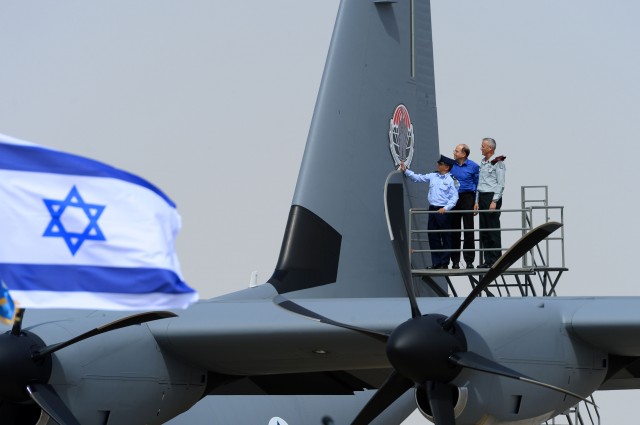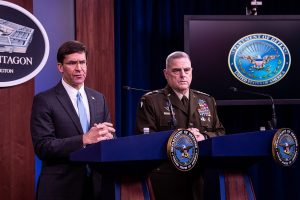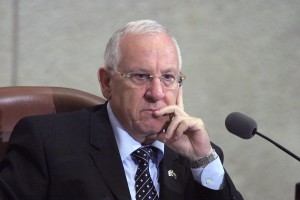by Marsha B. Cohen
Two celebrations brought Lockheed Martin’s CEO, Marilyn A. Hewson, to Israel on April 9.
Hewson officially opened Lockheed Martin’s office in Beersheba, the closest major city to where IDF technical units are being consolidated at new bases in the Negev Desert, which will be supporting the defense contractor’s “growing presence” in Israel. “By locating our new office in the capital of the Negev we are well positioned to work closely with our Israeli partners and stand ready to: accelerate project execution, reduce program risk and share our technical expertise by training and developing in-country talent,” Hewson said in her speech.
Then was the arrival of the first C-130J Super Hercules airlifter at Nevatim Air Base in Israel. The state of the art Super Hercules, fitted with “Israeli-specific, post-production modifications,” has been dubbed Shimshon (Samson) by the Israel Defense Forces, about which Hewson waxed rhapsodic:
This aircraft is worthy of its given name, Shimshon…[sic] a leader whose power was thought to be as mighty as the sun. Shimshon used his power to combat the enemies of Israel and perform heroic feats.In the same way, this aircraft will support the defense of Israel and the men and women who are the heroes of the Israeli Defense Force.
(Apparently Ms. Hewson is unaware that the biblical Samson/Shimshon (Judges 13:1-17:31), for all his strength, actually met a rather unenviable end — in Gaza — using his final surge strength to destroy himself along with the enemy. Yet the Philistines lived to fight another day and were still around a hundred years later.)
Much of the publicity heralding the Samson’s arrival emphasized the air transporter’s capabilities in carrying out humanitarian missions. According to Lockheed’s product description, “This rugged aircraft is regularly sent on missions in the harshest environments, and is often seen as the first aircraft ‘in,’ touching down on austere landing strips before any other transport to provide humanitarian relief after natural disasters.” Reuters notes that “In non-combat, but harsh, environments, C-130Js are often the first to carry out missions such as search and rescue, aerial firefighting in the United States and delivering relief supplies after earthquakes, hurricanes, typhoons and tsunamis around the world.” A Haaretz article anticipating the Samson’s arrival said that earlier versions of the Hercules aircraft had been used in 1976 to rescue hijacked Air France passengers being held hostage in Entebbe, Uganda and to transport Ethiopian Jews to Israel as part of Operation Solomon in 1991.
The Israeli Air Force website, however, describes the C-130J Hercules as “a tactical transport plane that is mostly used in joint missions with ground forces: supply missions, equipment transfer, airdropping combat forces and special missions.” The long version of the Super Hercules C-130J can carry 92 paratroopers and their equipment, which exceeds the 64 paratroopers the short version can accommodate. Comments by Israeli defense officials quoted in the Times of Israel suggest that Israel isn’t purchasing “Samson” for humanitarian intervention. The IDF Chief of Staff, Lt. Gen. Benny Gantz, who also attended the arrival ceremony, declared that the C-130J, which can fly close to the ground and land and take-off on primitive airstrips, was of “decisive importance” and would allow Israel to execute “more complex missions, under any conditions, deeper [within enemy territory], faster and more clandestinely.” IAF Commander Maj. Gen. Amir Eshel said that the “diversity of capabilities that the plane represents borders on the imaginary” [sic].
Israel orders its C-130Js, including the Super Hercules, through a Foreign Military Sale (FMS) contract with the US government. Israel’s annual Foreign Military Funding grant from the US signed in 2007 for a ten year period amounts to $3.1 billion to Israel annually (minus about $155 million due to the US government-mandated sequester). Considering that Israeli Prime Minister Benjamin Netanyahu budgeted $2.89 billion for an Israeli military strike on Iran’s nuclear facilities for 2013 and again for 2014, that doesn’t go very far, even when assuming that the Samson is being purchased with an eye toward war with Iran.
With Lockheed’s active involvement, Israel has been able to utilize a scheme called a deferred payment plan (DPP), in combination with a Pentagon process known as cash-flow financing, to make current purchases with deferred debt on favorable terms, to be paid with the FMS grants it is scheduled to receive in future years. Israel used this method to fund Pentagon-administered Foreign Military Sale purchases of Lockheed F-16I and F-35I fighters. Through this creative means of financing, Israel has already earmarked nearly all Foreign Military Funding through 2018 for F-35 fighter jets, heavy troop carriers, airlifters and other equipment.
Now Israel wants to buy — and the Pentagon wants to sell — half a dozen V-22 Ospreys, originally intended for the US Marine Corps serving in Afghanistan. What to do?
On March 20, during a visit to Israel, two members of the Senate Armed Services Committee, Kelly Ayotte (R-NH) and Joe Donnelly (D-IN), told Reuters that, in spite of belt-tightening in Washington, the US will continue providing Israel with military assistance after its current Foreign Military Financing package of $3.1 billion a year expires in 2017. Ayotte said that talks concerning the 2018-2028 package were already underway. Lockheed Martin is rated a “heavy hitter” among campaign donors by the Center for Responsive Politics’ Open Secrets website. Thus far in the 2014 election cycle, Lockheed has contributed over $1.6 million to members of the Senate and the House of Representatives, about two thirds going to Republicans and the rest to Democrats.
Ten days later, Defense News reported that Israel had agreed to take on more than $2 billion in commercial debt for near-term buys of V-22 tilt-rotor aircraft and other Pentagon-approved weaponry, trusting that the US will provide a 2018-2028 FMF package to foot the bill. Under a US-approved DPP, Israel would pay only interest and fees over the course of the current agreement set to expire in September 2018. The principal of the debt incurred to purchase the Ospreys would be covered by a new Obama-pledged package that would extend annual foreign military financing (FMF) aid through 2028. Lockheed loves the idea, even if the first purchase goes to a competitor. Why? Once the new means of proactive financing kicks in — Israel borrowing against an aid package it hasn’t even received yet, which, following approval, won’t go into effect for five years — Lockheed can expect benefits as well. According to Defense News, “Lockheed is expected to play a pivotal role in the new DPP scheme, which government and industry sources here say will facilitate follow-on procurement of Israel’s second squadron of F-35Is.”
Photo: Israel’s Defense Minister Moshe Ya’alon inspects the IAF’s newest recruit, the Samson Super Hercules. Credit: IDF Spokesperson’s Office






Thank you on this update Ms Cohen, especially the part of deferred debt. Perhaps you might also have an insight as to when the “official Israeli flag replaces the American flag flying over the U.S. Capital?” As to where the plant is located, seems rather shortsighted to locate it in the Negev, as well as the name of the aircraft, probably is fitting, as the Nuclear hole in the ground that Israel produces their WMDs that they wont give up, unless they bomb some other country, could be an omen, where the area will suffer a catastrophic accidental detonation of said Nuclear WMDs.
This is a sad story both for the United States and for Israel. As far as the United States is concerned, it shows how President Eisenhower’s warning about a military industrial complex has come true with a vengeance. Anyone who is interested in the continuation of US democracy should be worried about the close links between the military industrial complex and the politicians, especially in Congress, when huge contributions by the military industrial complex have distorted democratic principles and have turned politicians into paid agents of big corporations.
It is sad for Israel, because she is already the world’s most militarized society. One only has to read Patrick Tyler’s “Fortress Israel” or Seymour Hersh’s “The Samson Option” to see how the military elite run the country and prevent it from making peace with her neighbors. The saying “he who lives by the sword dies by the sword” is sadly true, and if Israel follows its present path its fate will be the same as that of Samson whom you refer to, and pride inevitably comes before a fall.
What Israel needs is not more weapons or more generals. She needs more farsighted politicians and peacemakers. Israel can either move to the point that she can bring down her neighbors with herself, or learn to live in peace with her neighbors. Any true friend of Israel should advise her to choose the second option.
This aircraft with the post production modifications for Israel will be a great asset for many types of operations. Militarily its capabilities are suited to the geographical surroundings of unfriendlies.
Better check that 1.7 billion USD figure representing LM’s political funding of USS & HR candidates thus far in 2014 election cycle. Sounds a bit unlikely.
It is misleading to characterize this as a U.S. “sale” and Israeli “purchase.”
If history is any guide, Israel’s U.S. lobby will make sure that the entire hardware and service bill is passed on to U.S. taxpayers.
If this piece were on the massive U.S. deal with Qatar—whatever one thinks of that—it would be accurate to characterize it as a sale since there is an actual transfer of value/compensation across borders—not just from taxpayers, to the U.S. Treasury to Lockheed.